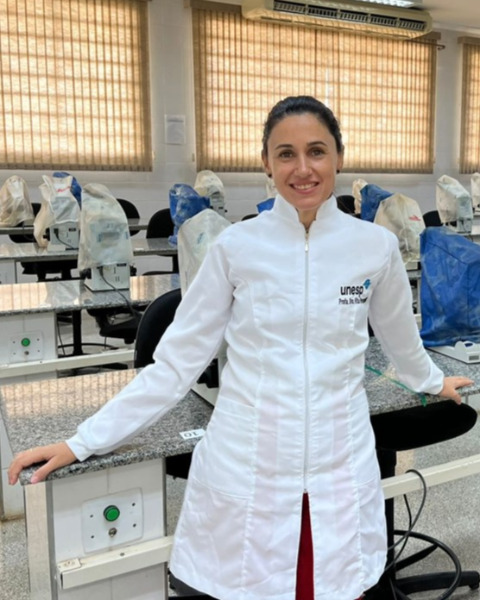Testis/Sperm
Poster Session C
(P-434) Molecular Interaction Between Nucleolus and Chromatoid Body of Male Germ Cells Evidenced by in Vitro and in Vivo Nucleolar Blocking
Friday, July 19, 2024
8:00 AM - 9:45 AM IST
Room: The Forum

RITA L. PERUQUETTI, PhD (she/her/hers)
Professor
Sao Paulo State University (UNESP)
Ilha Solteira, Sao Paulo, Brazil
Poster Presenter(s)
Abstract Authors: Rita L. Peruquetti1, Lucas M.V. Silva2, Luane F. Pereira2, Juliana M. Cardoso2, Letícia S. Giordano2, Wilson A. Orcini2, Lucas T. Rasmussen3
1. Departamento de Biologia e Zootecnia, Faculdade de Engenharia de Ilha Solteira (UNESP/FEIS), Ilha Solteira, São Paulo, Brasil
2. Centro de Ciências da Saúde, Centro Universitário Sagrado Coração (UNISAGRADO), Bauru, São Paulo, Brasil
3. Faculdade de Medicina de Marília (FAMEMA), Marília, São Paulo, Brasil
Abstract Text: The chromatoid body (CB) is a cytoplasmic structure of male germ cells that has a role in the regulation of mRNA transcription during spermatogenesis. It also participates in the control of gene expression through the action of small non-coding RNAs. The complete proteome analysis of CB molecular structure has identified abundant presence of their classical molecular markers, as well as the identification of many transient proteins (e.g., the nucleolar protein fibrillarin; rRNA 2'-O-methyltransferase). The nucleolus is a sub-compartment of the nucleus, which has the primary function in the biogenesis of ribosomes. It has been shown that the nucleolar cycle during gametogenesis contributes to the reestablishment of nucleolar morphology, which is an important factor for removal of induced cell damage.
Here, we evaluated the effect of nucleolar blocking on the CB organization. BMH-21, an RNA polymerase I (Pol I) inhibitor, was used to block the nucleolar activity in male germ cells in vitro and in vivo.
We found a change in the amount of MVH protein in germ cells of the groups treated with BMH-21 by WB analysis, as well as the failure in the structural organization of the CB in germ cells undergoing the same treatment by IF analysis. Additional data collected in vivo detected the physical interaction between fibrillarin and MVH by Co-IP. Moreover, RT-PCR analyzes in germ cells of animals treated with BMH-21showed increased expression of Gm10486, a gene normally kept silent in the CB.
Our results corroborate previous evidence of the link between the physiology of the nucleolus and the CB in male germ cells, which reinforces the role of these structures in determining male fertility.
1. Departamento de Biologia e Zootecnia, Faculdade de Engenharia de Ilha Solteira (UNESP/FEIS), Ilha Solteira, São Paulo, Brasil
2. Centro de Ciências da Saúde, Centro Universitário Sagrado Coração (UNISAGRADO), Bauru, São Paulo, Brasil
3. Faculdade de Medicina de Marília (FAMEMA), Marília, São Paulo, Brasil
Abstract Text: The chromatoid body (CB) is a cytoplasmic structure of male germ cells that has a role in the regulation of mRNA transcription during spermatogenesis. It also participates in the control of gene expression through the action of small non-coding RNAs. The complete proteome analysis of CB molecular structure has identified abundant presence of their classical molecular markers, as well as the identification of many transient proteins (e.g., the nucleolar protein fibrillarin; rRNA 2'-O-methyltransferase). The nucleolus is a sub-compartment of the nucleus, which has the primary function in the biogenesis of ribosomes. It has been shown that the nucleolar cycle during gametogenesis contributes to the reestablishment of nucleolar morphology, which is an important factor for removal of induced cell damage.
Here, we evaluated the effect of nucleolar blocking on the CB organization. BMH-21, an RNA polymerase I (Pol I) inhibitor, was used to block the nucleolar activity in male germ cells in vitro and in vivo.
We found a change in the amount of MVH protein in germ cells of the groups treated with BMH-21 by WB analysis, as well as the failure in the structural organization of the CB in germ cells undergoing the same treatment by IF analysis. Additional data collected in vivo detected the physical interaction between fibrillarin and MVH by Co-IP. Moreover, RT-PCR analyzes in germ cells of animals treated with BMH-21showed increased expression of Gm10486, a gene normally kept silent in the CB.
Our results corroborate previous evidence of the link between the physiology of the nucleolus and the CB in male germ cells, which reinforces the role of these structures in determining male fertility.
